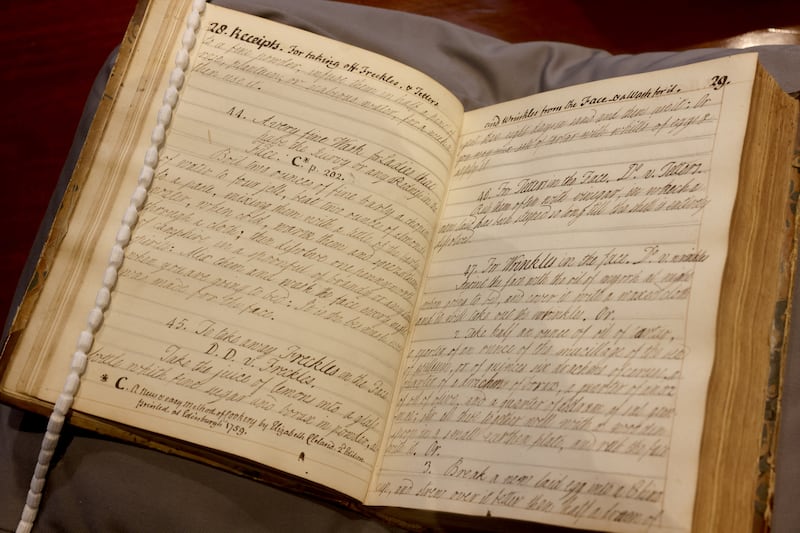A 19th century cake has prompted archivists at the National Library of Ireland to uncover more about our culinary heritage and traditions.
Nora Thornton and Joanne Carroll are assistant keepers with the NLI’s special collections. Thornton works in photographic archives and Carroll in manuscripts. However, in addition to their other duties, the keen home cooks have taken a particular interest in library materials that relate to food.
“Nora and I love talking about food – that’s all we do when we get together,” explains Carroll. So much so that they put together a public talk, Cooking The Books, which they have now given twice, introducing some of the library’s gastronomic collection. “One of our problems was picking what to include, but our selection ranged from an early published manuscript up to a website, as we now keep a web archive.”
Thornton. adds: “We also wanted to show that it was mostly women that cookbooks were written by and aimed at, whereas other types of books were mostly written by men.”
RM Block
Their selections included an Irish Countrywomen’s Association cookbook from the 1960s; and Irish Country Recipes by Florence Unwin from 1937: “ ... The lazy woman refuses to cook a meal when she can walk round the corner to the delicatessen shop and obtain a dinner from a collection of cans … ”
The inspiration for these talks began with a loaf of gingerbread. “We have a very competitive annual baking contest in the manuscripts department,” explains Thornton. “One year, I chose a recipe from a manuscript – just for brownie points because the judge was an ex-member of staff. The cake sank, but I still won because of where the recipe came from.
“It was a normal, if large, recipe – one pound of sugar, one pint of treacle, two pounds of flour, a teacup of ground ginger, six eggs and a pound of butter. They used potassium carbonate or pearl ash to get it to rise, which is pretty poisonous. I don’t know what they were thinking putting it in cake, but it’s all they had. I used bread soda.

“So that loaf is what piqued my interest. And then during lockdown, any time we were allowed on site, I’d come in and take a few pictures of some recipes, go home and make them, and do a social media post. It was very interesting, though some of the recipes were disgusting. There was a lemon cake with 12 eggs in it, and it was basically an omelette with hardly any lemon flavour. Another for beef steak pie was just beef and onions in a pastry, nothing else. And there was a parsnip pudding that you could make savoury or sweet. I did both.”
A book might say: ‘Lady so-and-so visited and gave her recipe for…’ So it tells you a lot about what families were friends, and who socialised with who. There is not a lot of women’s history, so stuff like this can fill in some of the blanks
— Joanne Carroll
All these recipes came from manuscript 42009, Thornton’s favourite from the collections. It was compiled by Anne Irvine, who, further research showed, was the unmarried daughter of a doctor who lived at Rosebank, in Moville, Co Donegal.
“Some of the recipes are dated, and say who she got them from.” A recipe for “green oil” comes from Old Mr Woodright, Gola House, Monaghan in 1855. M Lindsay’s parsnip pudding is attributed to the magazine of Domestic Economy.
In these and other old manuscripts, recipes for food and medicinal cures are written side by side. “I came across a recipe for cooking oysters, and there was a cure for a mad dog bite beside it,” recalls Carroll. Another manuscript, the 18th century “Curious Receipts” by Jane Burton from Co Clare, comes complete with an indexed contents lists. Recipes for preserves and jams have been copied out alongside cures for stinking breath, and “To keep from wrinkles” – steaming with white wine and myrrh.
“A lot of these books would be collaborative,” says Carroll – some were compiled over the span of almost a century. “When it was a landed estate, you can tell what visitors were at the house, because a book might say: ‘Lady so-and-so visited and gave her recipe for ...’ So it tells you a lot about what families were friends, and who socialised with who. There is not a lot of women’s history, so stuff like this can fill in some of the blanks.”
So was it usually the lady of the house, or the cook, who collected and recorded these recipes? Both, says Thornton. “However, they think a lot of the cooks couldn’t read. Then the lady of the house would keep the recipe book, and if she went to visit her friend’s house, and they had a really nice biscuit, she would ask for the biscuit recipe and then tell her cook how to make it.
“Or there would have been a copy kept for the lady of the house, and a kitchen version with the cook’s own notes. You can tell when a cookbook is in a really bad condition that it has been used in the kitchen, like our own cookbooks with wooden-spoon stains and splatters.

“Only the upper classes had the time and the money to put together books like this,” continues Thornton. “There are no recipes for what poor people had to cobble together. So it’s always nice to find something that’s not from a big house.”
Lucky finds include a lined copybook from the 1920s, found among the papers of Prof Tomás Ó Máille, filled with recipes and signed by Sorcha Bean Uí Chonaill. “It was really lovely to come across something written in Irish, she says. “We’re constantly surprised by what we have. You can be looking for something else for a reader and suddenly go, “Oh, look at this”.
Thornton says they would love time to do more research within the manuscripts, and perhaps find links between different people and their recipes. “If we had a cookbook from a big house in every single county in Ireland that would be a start,” she says. “However, we’re not academics in this area. We just know what we have and where to find them. That’s why we need readers to come in and research.”
“Our printed materials are also really interesting,” says Carroll. “For example ‘Court cookery’ from 1724 is by the King’s chef.” Upper class cookery also dominates more recent productions. “‘Culinary Adventures’ from 1933 has a foreword by the Duchess of Abercorn, and the recipes were collected and compiled by Mrs Reginald Clark and Mrs Richard Pimm – even in a printed book they didn’t get their first names – with proceeds to the Belfast Hospital for Sick Children.” Recipes compiled by these well-to-do ladies included American Fish Pie and “gnoechi”.
Carroll’s choice from the collection is a book published during the Great Famine: Cheap Receipts and Hints; Cookery Collected for Distribution Amongst the Irish Peasantry in 1847. Written by the Countess of Caledon, Catherine Alexander, it offers recipes for alternatives to potatoes, including tortillas from Indian corn, rice and turnips, and sheep’s head soup – presuming one was able to find a turnip or sheep’s head.
“It was extremely condescending,” says Carroll. “Basically she was saying that the time spent queuing for the soup kitchen could have been better used; distributing soup does not answer half so well as teaching people how to make it at home. [That] the time lost in waiting at a soup kitchen might be occupied in some useful employment, by which the poor people could earn more money than the quart of soup is worth.”
[ JP McMahon: In defence of old cookbooksOpens in new window ]
Carroll even made one of Alexander’s suggestions for their first public talk – “I cooked tripe in the slow cooker with onions for about eight hours; people were generally surprised that it didn’t taste that bad.”
“If I was born 200 years ago, I would be eating potatoes and soup or barley. Now, I have so much choice,” she says. “I can go to a Mexican restaurant or an Ethiopian restaurant, which reflects a change in Ireland for the better, immigrants coming in and bringing their food.”
However, there are common threads across the centuries. “There are a lot of stews and using the whole animal, which is all back in fashion. Bone broth may be a big thing now but they were making these broths and stocks hundreds of years ago. From the 17th century right up to the 1900s there are a lot of pickles, and that’s something else that has become popular again.” However, pickling in previous centuries wasn’t for gut health. “They didn’t have fridges. So it was the main way to preserve safely. They pickled everything. I’ve even come across pickled pigeon,” says Thornton.
“Some of the things they were eating are just plain weird, but others we are still eating today,” says Thornton. And some other things remain the same, she concludes. “People still have their own little books that they use to keep recipes in and they make notes on recipes, and tweak things. In the past, recipes were collected during visits, and people still get recipes from friends, on social media or when they go to a friend’s house for a dinner party. We’re all still finding and sharing recipes – just in different ways.”














